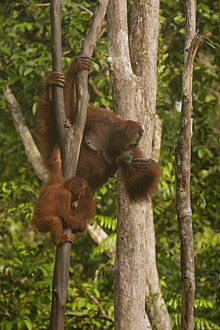| Bornean orangutan | |
|---|---|

| |
| Male | |

| |
| Female with infant both at Tanjung Puting National Park, Borneo | |
| Scientific classification | |
| Domain: | Eukaryota |
| Kingdom: | Animalia |
| Phylum: | Chordata |
| Class: | Mammalia |
| Order: | Primates |
| Suborder: | Haplorhini |
| Infraorder: | Simiiformes |
| Family: | Hominidae |
| Genus: | Pongo |
| Species: | P. pygmaeus
|
| Binomial name | |
| Pongo pygmaeus (Linnaeus, 1760)
| |
| Subspecies | |
| |

| |
| Distribution of Pongo pygmaeus in Borneo | |
| Synonyms | |
|
P. agris (Schreber, 1799) | |
The Bornean orangutan (Pongo pygmaeus) is a species of orangutan endemic to the island of Borneo. Together with the Sumatran orangutan (Pongo abelii) and Tapanuli orangutan (Pongo tapanuliensis), it belongs to the only genus of great apes native to Asia. It is the largest of the three species of orangutans. Like the other great apes, orangutans are highly intelligent, displaying tool use and distinct cultural patterns in the wild. Orangutans share approximately 97% of their DNA with humans.[2] Also called mias by the local population,[3] the Bornean orangutan is a critically endangered species, with deforestation, palm oil plantations, and hunting posing a serious threat to its continued existence.
- ^ a b Ancrenaz, M.; Gumal, M.; Marshall, A.; Meijaard, E.; Wich, S.A. & Hussons, S. (2018) [errata version of 2016 assessment]. "Pongo pygmaeus". IUCN Red List of Threatened Species. 2016: e.T17975A123809220. Retrieved 17 January 2022.
- ^ "Orangutan facts". Orangutan Foundation International. Retrieved 2012-03-17.
- ^ Wallace, Alfred Russel (2008). The Malay Archipelago (Rev. pbk. ed.). Singapore: Periplus Editions. p. 47. ISBN 978-0794605636.
